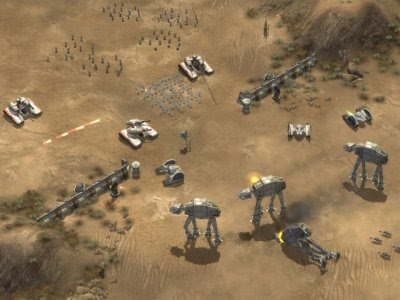
Single player puts you in the role of a Lt. Parker, just as the Soviets invade Seattle. The campaign is of average length, but involves good mission variety. WiC is not so much a typical RTS, with no base-building or resource management. Instead, the player gets a set amount of reinforcement points, which can be used to bring in different units. Once units are destroyed, their points eventually return to the pool, allowing you to repurchase additional units. Most units also have an offensive and defensive ability, giving them an extra push when needed. The other big point to the game is Tactical Aid. As you fight the enemy and take over control points, you gain TA points, which can be used for radar scans, artillery barrages, and airstrikes. It is extremely fulfilling to watch your artillery fall upon the enemy forces, or watch them walk right into your tank buster’s line of fire. All portrayed in the most beautiful way I have ever seen in an RTS, with every object being destructible, and every artillery round leaving a crater.



As I said, multiplayer is where WiC comes into its own. Most servers are dedicated, not personally hosted, so there are always servers to be played on. When you enter a server, you can choose between the US/NATO or the USSR, and also a certain role. Multiplayer revolves around fulfilling your role, choosing from infantry, armor, air, and support. Infantry and armor are self-explanatory, air allows you to control helicopters, and support gives you powerful artillery and anti-air units. Different game types are also available: domination, which is taking more control points than the enemy; assault, where one side attacks the other’s control points and then switches to defense on the same map; and tug-of-war, where one team must take a row of control points to push a frontline forward. The level of destruction is unprecedented, with up to 16 players throwing in dozens of air and artillery strikes upon the beautifully rendered scenery. Tactical nuclear weapons are also seen occasionally.

An example of Tactical Aid, a Daisy Cutter bomb dropped from a cargo aircraft, and no where near as powerful as the tactical nuke
I will not lie; when I first saw WiC I was not overly excited, because it did not seem to reach the veteran RTS player. But after playing it for many hours, I can tell this will be one of my all time favorite RTS’s. I love the story, I love the multiplayer, I love the graphics, and I love the gameplay. This is simply an awesome game. If you are looking to get into the RTS genre, then this is a great learning game for beginners. If you are an RTS vet and looking for something more, then WiC will deliver its great content in good fashion. I highly recommend World in Conflict, and will be playing it for time to come.











